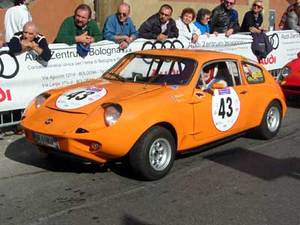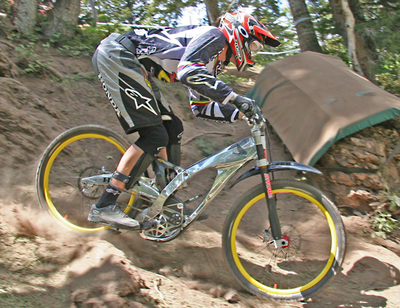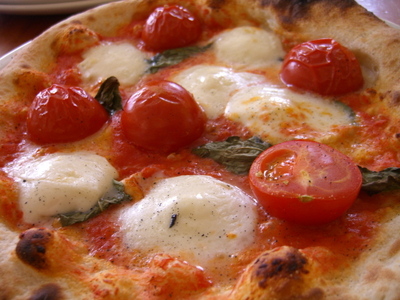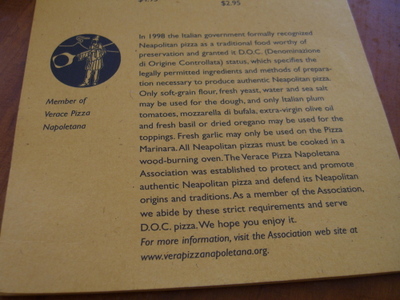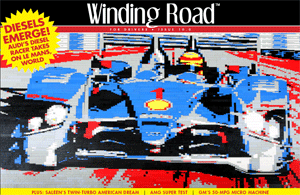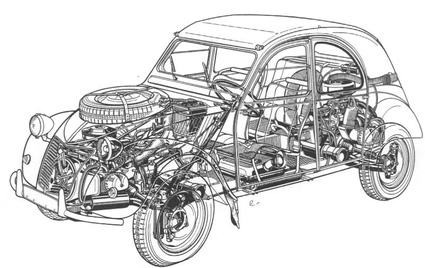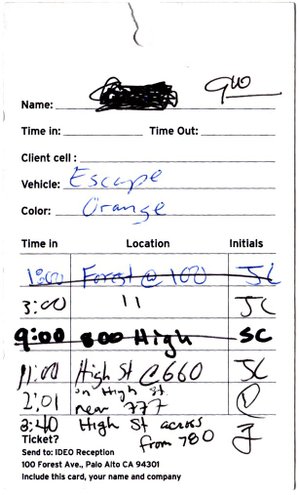As driven by Paolo Arbizzani of Scuderia Bologna at the Gran Premio Bologna-San Luca. I’ve got to figure out a way to be hanging around (or driving?) in Bologna — a rabid center of gearhead gnaryless if there ever was one — come June 2007.
Author Archives: Diego Rodriguez
metacool Thought of the Day
"[W]e must consider the possibility that if Design
Thinking is critical, maybe restricting it to designers and protecting
them from business people is not actually the most productive avenue to
pursue. Perhaps eliminating the need for protection by turning business
people into Design Thinkers would be more effective.
… Rather
than supplementing modern analytical management with design
sensibilities, it is time to integrate design into management practice.
The job of executives isn’t to protect designers from line management,
but to help line management become Design Thinkers. It is time for the
management discipline of Design Thinking.
To create a Design
Thinking organization, a company must create a corporate environment in
which it is the job of all managers to understand customer needs at a
deep and sophisticated level and to understand what the firm’s product
means to the customer at not only a functional level, but also an
emotional and psychological level… It must create an operating environment by which line managers
experiment with new ways of delighting the customer, realizing fully
that some new ideas will fail, but that in failing these efforts have
valuable benefits. Even failed experiments help convince customers that
the company is aiming high, and the feedback will help them come up
with newer, better approaches.
…The great firms of the 21st century will be those that
recognize the goal isn’t to supplement analytics with design; it is all
about integrating design and management."
More thoughts on innovating routinely
BWJones, who is a card-carrying member of the Union of Unabashed Appreciators of Gearhead Gnarlyness, snapped this tasty photo above of a downhill mountain biker at work in his bike. In addition to writing a very cool, extremely gnarly blog, Dr Jones focuses on something called metabolomics. Fan that I am of all things meta, here’s what that means:
Metabolomics is the analysis of micromolecular networks that form the currencies and currents of life. Every cell exists in a metabolic N-space where mixtures of intra- and
pericellular micromolecules are shaped by cell-autonomous and
non-cell-autonomous factors. No theory predicts these mixtures, partly
due to the paucity of micromolecular profile data from which a coherent
model could be crafted. Profiling with single-cell resolution in
complex tissues is essential to decoding the interactions between gene
expression and environmental signaling.
Sweet. Now back to that bike. Look closely at the pedal area. Interesting, eh? It’s missing the normal chainring and gear set. The story gets even more interesting when you learn that bike is a Honda. For a few years now, Honda has been evolving a fundamental re-think of the bicycle power transfer mechanism. As is typical of their "just build it" culture, they’re using racing as the laboratory to push forward the process of iterative information creation, which is a powerful way to innovate whenever you’re at the edge of what’s known.
Honda is a master when it comes to innovating on a routine basis. Yeah, so I’m a pro-Honda cheerleader — hey, I call ’em like I see ’em. But from the standpoint of routine innovation, Honda is a soul mate to Google, Apple, and other great innovators. What Honda shares with Google is the ability to routinely go back to first principles on everything it chooses to work on, no matter the market. From a philosophical perspective, for example, I see very little difference between GMail and a Honda Ridgeline — both took a product category bereft of innovation and redefined the offering from a blank sheet of paper. Each was a fairly radicial rethink. For an example of a milder form of ongoing innovation, look at the parallel between a Honda Odyssey and Google Search. Both are in the business of doing a mainstream activity — carrying people and search — but the each just do it better thant he competition, and they do so transparently and with great simplicity and elegance, so the big middle of the market loves them.
Oh, and by the way, they’re about to apply the same penchant for first principle innovation to the small jet market. Honda, that is. Not Google. Yet.
Food, authenticity, and brand halos
Warning: this is a relatively long, rambling post because I’m thinking out loud.
What makes something authentic? When are things not fake? Can something be designed to be authentic, or does the act of considering authenticity at a conscious level doom something to the land of the artificial? I’ve been swishing these questions around for a while. I’m not sure yet. I’m sounding out things here in the sandbox of this blog. Help me out if you care to.
When I write about the visceral aspects of stuff, I like to focus on cars, because the experience we all share in common of them which makes the conversation easier. For similar reasons, when it comes to discussing authenticity and design, I find that food makes for the best subject. Think about it: when was the last time you heard the word "authentic" being used to describe anything other than food? I’m sure you have but food seems to live near the center of the authenticity universe. As an example, Russell Davies just wrote a great book all about authentic eggs-and-bacon dining experiences. If car-based sensations of speed and acceleration inform our understanding of the design of visceral experiences, then concepts like terroir and appellation from the world of food should be a way to gain a deeper understanding of authenticity.
Enough philosophizing. Let’s eat.
I recently had a pizza at a restaurant by the name of Two Amys. It was very, very good:
I’ve never been to Naples. But when I look at the picture above, I can taste the lactic whisper of the mozzarella and I’m reminded that this bubbly dish was one of the best pizzas I’ve ever eaten. Tasty? For sure. Authentic? I believe so — but can I really know without having been to the source?
Peruse the menu between bites. Ho ho ho, what’s this?
The Two Amys chooses to spend some very precious menu space to explain how their fare meets the standards set out by an independent pizza standards group called Verace Pizza Napoletana. The standards are precise and fairly strict. From the Verace Pizza Napoletana website:
Basic
Requirements
1. A wood-burning oven: The pizza must be cooked by wood. Gas, coal or electric ovens, while they may produce delicious pizza, do not conform to the tradition.
2. Proper ingredients: 00 flour, San Marzano (plum) tomatoes, all natural fior-di-latte or bufala mozzarella, fresh basil, salt and yeast. Only fresh, all-natural, non-processed ingredients are acceptable.
3. Proper technique: Hand-worked or low speed mixed dough, proper work surface (usually a marble slab), oven temp (800°F), pizza preparation, etc.
4. Review by the designated representative of the association assuring that the ingredients, technique and final product conform to the tradition.
5. Each individual restaurant is bound to uphold the standards of the association. Moreover, each individual restaurant is bound to pay a membership and membership renewal fee. Hence, membership fees do not apply to any new units opened subsequent to joining VPN, nor is membership transferable from one location to another. Rather,
each individual location is evaluated and billed separately. In the event of non-compliance by one or more of my restaurants, the VPN association maintains the right to suspend or rescind membership on an individual or collective basis.
This is a clever device, this appeal to an external maven of authenticity. Putting it on the menu validates what my taste buds were telling me, and it’s a powerful story which places a halo of authenticity around the entire Two Amys brand. It tells me that this pizza is the Real Deal. It’s authentic so long as a believe that the VPN is authentic and real. Is it? I hope so.
Halos of authenticity are, I think, a useful way to help meaning and value become associated with a brand. For example, when Subaru rallies its cars, it’s hoping that success there will put a halo of racing toughness and speed over their brand. And so on and so forth. What do you think?
Live webcast of my AlwaysOn keynote
You can find a live broadcast of my AlwaysOn keynote here live at 8 AM PST, Wednesday July 26.
Bob Sutton and I are going to talk about Tales from a Double-Wide Trailer, which is a story about the lessons we learned from teaching our Creating Infectious Action class at the Stanford d.school. Then we’ll have a group discussion about stoking contagious behavior with:
- Mitchell Baker, CEO of Mozilla.org
- Perry Klebahn, founder of Atlas Snow Shoes
- Gil Penchino, CEO of Wikia
If you’re online while we’re onstage, please please submit a question for the panel discussion, and we’ll try to make it part of the discussion.
The organizers of the conference have put in place two interesting innovations. First, the bloggers are sitting in the front row at a table reminiscent of something out of a McMenamin’s brew pub movie theater, instead of in their customary back-of-the-auditorium position. Second, there’s a rolling screen of comments from people online. So far some have been funny, some rude, some trenchant, some insightful. Interesting stuff.
Pink on Returns on Design Thinking
Dan Pink’s latest column talks about tracking the market performance of design-thinking companies: Who’s your DADI?
TEDBlogging
I’m still whipping up the occasional post over at TEDBlog.
Some recent entries:
While you’re there, check out the TEDTalks Joshua Prince-Ramus video. Great storytelling, great design thinking.
IDEO Prototypes the Future
My second IDEO-centric post in as many weeks! My, how I’m violating the self-imposed house rules here at metacool!
If you’re going to be in or near Palo Alto before September 10, and if you’re at all interested in innovation, design, and business, I encourage you to check out a nice new exhibition at the Palo Alto Art Center called IDEO Prototypes the Future. It’s a great retrospective of IDEO’s work over the years, and more importantly, I think the exhibition does a marvelous job of showing our design process in action. Innovation need not be a mysterious thing; it’s mostly the result of hard work and persistence and optimism coupled with a deep-rooted sense of optimism. And it doesn’t hurt to have a happy group of people who love working together, either.
If I were to attend, I’d download this podcast by IDEO CEO Tim Brown to my iPod, and listen to his personal gallery walkthrough while I meandered through all the stuff on display. The coolest part of the exhibit for me was seeing the shopping cart we did for Nightline (shown above) with the Nightline show playing behind it. There’s a (slightly) younger Diego there building prototypes and uttering something about a "SUV shopping cart", among other things… I used to think my biggest impact on modern culture would be the bazillions of parts made off of my designs for HP inkjet printers over the years, but now I think it’s probably going to be the Nightline video, which has taught lots of people about the human-centric design process in the years since its debut.
So please check it out. And don’t just trust my word for it (I love IDEO, so I am biased, after all) — see my friend (and fellow We Know member) Ross Mayfield’s blog for another review of the show.
July 18 update: Robert Scoble attended the opening night on behalf of his new company PodTech (which is why I’m on this podcast) and says that the exhibit "… is freaking awesome. If you’re a design nut, you need to see this."
Unabashed Gearhead Gnarlyness
Need four-wheel-drive off-road capabilities? Stick a second engine and transmission in the rear. Panoramic sunroof? A roll-back canvas roof will do.
Audacious. French. A way of thinking beyond the obvious that’s gone missing from Citroen in the decades that passed since a gnarly old Sahara last roamed the rocky roads of southern Spain, but whose iconoclastic sensibilitly can still be found in the work of the crazies at Honda.
Making Petty Parking Problems Go Away
As a rule, I don’t write much on metacool about my work at IDEO. It’s less that 120% of my IDEO stuff is swarming-ninjas-will-be-sent-out-to-slay-me-in-the-silence-of-the-moon confidential (which it is), and more that this blog is my personal sandbox. It’s about everything I do at work, but it’s not about my work. But today I make an exception, because I reckon the story is pretty cool.
Context: Parking in Palo Alto, where I work, is tough. Not as tough as, say, downtown Tokyo, but certainly on that end of the bell curve. The Palo Alto Police ticket mercilessly. Even though I’m extremely careful, I’ve been known a ticket or two. Come to think of it, given the taxes I kindly fork over each year, I should be gifted a diamond-encrusted personal parking spot by my local elected officials. As well as a gold-leaf wrapped box of Macanudos. Monthly, via FedEx. But I digress.
Blogger and IDEO client Robert Davis tells a delightful story about the frustrating experience of parking solo near our Palo Alto headquarters, and then about the delightful experience of parking with the aid of the IDEO Experience Team. Listen to my favorite bit of his post:
Here’s what: service is sometimes about giving the user the tools to
manage the situation themselves; sometimes it’s about making the
problem just go away. IDEO has figured out that when you’re bringing
people in to do creative thinking about a business problem, you’re
better off making their petty problems, like parking, just go away.
I won’t even pretend to be able to say it better. Thanks, Robert!

